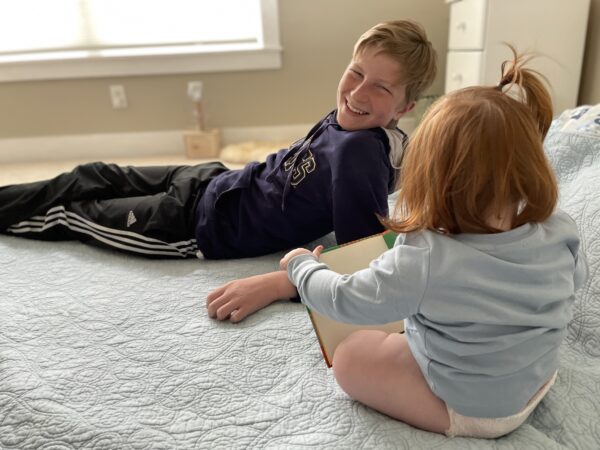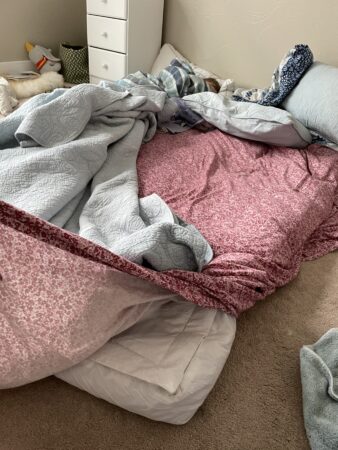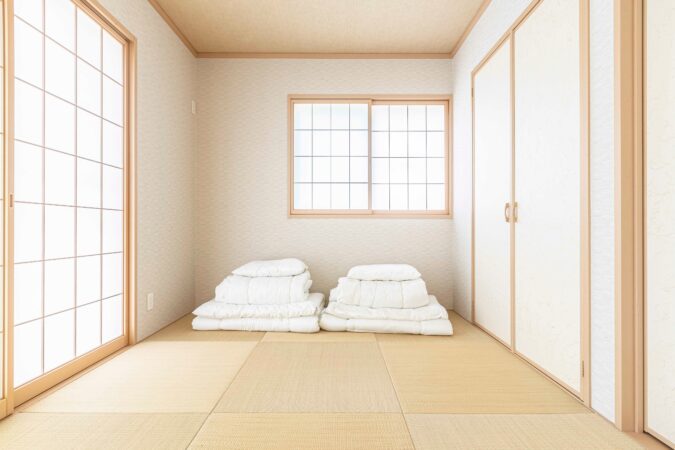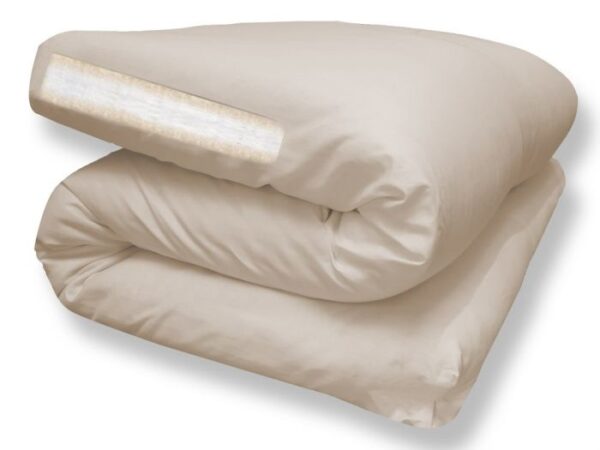Has spring cleaning ever resulted in you getting rid of your bed and mattress… and not replacing it? This impulsive decision to try floor sleeping ended up being a great one for me. In Japan, as well as many other countries, floor sleeping is normal and common. Despite this, there are very few studies or even literature about this way of sleeping at all.
Most of us believe that we need the support of a mattress to sleep well. But it’s not correct just because the mattress companies say it, is it?
I started floor sleeping because I didn’t like my mattress and didn’t want to spend the money on a natural mattress to replace it (see the natural mattress that I like here). I thought I would try putting just a mattress topper on top of box springs and see how that went. As I was looking for natural mattress toppers, I came across a few YouTube videos where extreme minimalists talk about floor sleeping.
Eager to get moving on my spring clean-out and deep-clean under my bed, I put my mattress to the curb and was then committed to sleeping on the floor (or sharing a twin bed with one of my kiddos) until I had a replacement.
Sink or swim baby!
Benefits of floor sleeping (for me)
I thought I had sworn off sleeping on the ground when camping not long after I turned 30. “I’m too old for that” I claimed. But, like many things turn out, I think the opposite may actually be true- sleeping on the floor on a regular basis actually makes me feel much younger! After an initial adjustment of a few days, I sleep well on just a flat sheet on the carpet, and I wake up feeling GREAT.
Wake up feeling like I’ve had a massage
I can’t even describe how good I feel! I’m 38, but I wake up every morning feeling loose and energetic and like I’m in my early 20s again! I’m feel better when I wake up than I ever have in my life- like I just got done with a long restful spa day complete with a great massage.
Better posture during the day.
With all our electronics, many of us spend way more time than humans ever had in human history in a hunched or rounded position. Even with ergonomic work stations, as a whole, our posture isn’t great.
More energy all day
I don’t know why this is, but I felt an uptick of energy, but not jittery nervous energy, the whole next day. I popped up and down to help kids on the floor and around the house with ease.
Easier movement all day
My movement is easier after floor sleeping. I had started ‘oof’ing while I was getting up while pregnant, and it continued. I noticed my ‘oofs’ were gone, and I really felt extra flexible and springy.
No creaking joints
The first night of sleeping on the floor had my joints snap-crackle-popping all night long, but the next day they felt extra great. I don’t really have joint issues, but I occasionally have carpel tunnel from carrying around a toddler (and have since I had my first). That has been gone since I’m floor sleeping. I also noticed that the occasional popping and clicking that I associated with now being in my late 30s are gone after floor sleeping. Floor sleeping is keeping me young!
Feeling like my house has more space
My room feels huge now! I leave my bed set up most of the time, but the fluid movement from bed to floor makes it feel very spacious and is my favorite room in the house again.
General sense of well being.
I suspect the continued resistance of sleeping directly on the floor has a nervous-system balancing that happens while we sleep. Floor sleeping feels good, and even with the initial discomfort of learning to sleep like this. I still enjoy this way of sleeping much more than I thought I would! I thought it was something I could learn to tolerate as an experiment, but I really do like floor sleeping and will happily continue.
Initial adjustments to floor sleeping
The first night I was solidly unimpressed with my decision to floor sleep. My hips hurt, my shoulders hurt, and I used about 7 pillows and woke up about 17 times. I was cold, and I felt like I barely slept. However, once I was actually up, I felt great albeit tired.
Each night got progressively better, and after a week I used one pillow sometimes, but mostly just slept great on my back or stomach on the floor.
If you think about it, our whole lives we’ve been in a ‘supportive’ bed that supported our daytime bad posture through the night. This is going to take some time to undo- just like we might be a little sore after going to the chiropractor or physical therapist.
Cons of floor sleeping
Everything has pros and cons, and where we choose to sleep is another controversial one! Here are the disadvantages that I could find.
The adjustment period
Plan on a couple nights of not-great sleep as you get used to this method of sleeping. I covered this above. I would suspect that the amount of time it takes to adjust will vary depending on your overall health and body condition.
Floor sleeping is colder
Our bodies seem to really like us to be a little bit miserable. I was cold at first, and tried putting a featherbed under my floor system. With that featherbed I was warmer, but didn’t feel as good the next day! That was an interesting observation. I tried again the next night and noticed the same thing. So the 3rd night I removed the featherbed and again felt great the next day.
At the time of my experiment it was spring, I’ll see if the featherbed is a good option in the winter when it’s getting below 0 on a regular basis.
Moisture buildup
If you live in a part of the world that has humidity, there can be an issue with moisture buildup and even mold and mildew forming under a floor sleeping system. Tatami mats are specifically designed to reduce/eliminate this. You also can easily hang up your floor sleeping items by placing them over a chair and airing out in the sunshine on a regular basis.
Here in Montana our climate is so dry that we don’t have to worry about this. I often shake out or fold up my bed, and vacuum under it.
Floor Toxins
If you are sleeping right on the floor like I am currently, there may not be all that many reductions in toxins. My carpet? Polyester. Under the carpet? Synthetic mattress pad. Under that?! OSB, which is compressed wood chips with synthetic adhesive holding it together. Ahh, it’s an ever present cycle of modern ‘improvements’ that are not idea for our health.
Some solutions to the floor toxins are to sleep on a Japanese tatami mat (buy here), which is made from straw and grass. If you have wood floors, you’re already on your way to a natural sleep surface. Topping wood with a wool rug or sheepskin would be another sustainable (and in my opinion pretty!) alternative.
Still, we know that mattresses not only off gas, but almost always are treated with chemical flame retardants. So while I don’t have any direct comparisons, I suspect that my floor is far less toxic than a conventional mattress.
Read: The Importance of Natural Mattresses: Get the toxins out
People will think you’re weird
No doubt, this is one change you may want to keep to yourself for the most part. Most people will parrot back the mattress commercial verbage that you ‘need’ a ‘supportive’ mattress for health and to feel good. My experience says differently! But I don’t need to convince anyone.
You’ll end up wanting to get rid of all your furniture
After I got used to floor sleeping I found myself wanting to get rid of all my furniture. We would have so much more room and improve our movement and flexibility so much! I reigned myself in, and will be keeping our couch and dining room table.
I may move the table out in favor of floor eating as a team building exercise, but for now I will leave the main area of my house ‘normal’.
Really, though, you will feel so good that you’ll be spending a lot more time on the floor and enjoying the feeling of good posture all the time!
Are There Studies on Floor Sleeping?
Despite being commonplace many countries, including the highly technologically advanced Japan, floor sleeping doesn’t have many studies.
What are floor sleeping systems?
In Japan people commonly sleep on shikibutons on top of tatami mats. Shikibutons are Japanese futons that are commonly rolled up and stored away during the day, and then unrolled at night. They are similar to American futons in that they are a pad over a solid frame, but they aren’t folded into couches the way American futons are.
Tataimi mats are traditional flooring and sleeping surfaces from Japan. They commonly cover an entire room and are used for everything from eating to sleeping to playing. When looking at tatami mats, check to make sure they are made of 100% straw and grass fibers.
Links to buy Tatami Mats:
When choosing a shikibuton, traditionally they are made of 100% cotton. You can find them made of many different materials now. I would recommend making sure they don’t have flame retardant or synthetic fillers such as polyester.
Two twin-sized or twin XL shikibutons are easier to move around for airing out or traveling rather than getting one Queen sized. Three inch is the traditional thickness.
- Cotton Shikibuton (Amazon)
- Cotton Shikibuton (The Futon Shop)
- Cotton and wool Shikibuton
None of these are necessary for floor sleeping, but if you are interested in a more natural bedding option that still has the look of a traditional bed, they may be a good option for you. A tatami mat or bed is also a great solution if you live in a humid location or want to be up off the ground a little bit.
How to start (without getting rid of your bed)
If you’re not ready to jump all in and get rid of your bed, have no fear! Many people have started floor sleeping on just a thin camping mat or yoga mat in the space next to their bed to see if it was something they wanted to keep up with long term.
It’s recommended to have as many pillows as you want to start out, and then gradually reduce them until you are flat on your back or belly most of the night.
You also want to be prepared that it will feel cooler- a welcome break in the summer time, but have some extra blankets near by if it’s a cool time of year.
If you stick out the initial discomfort, I am confident you’ll enjoy how you feel in the morning. You’ll also love the extra found space in your home!
What else are we wrong about?
The more we look at different cultures, the more we see that simplicity is healthier- and it’s free and often less time consuming than our modern American habits.
- I Don’t Let My Kids Eat Snacks and We Are Healthier Because Of It
- My Kids Don’t Need Braces Because Of Meat and Butter
- Why Your Family Needs Cod Liver Oil
- Review: Lies My Doctor Told Me: Medical Myths That Can Harm Your Health
- Alcohol Lies
- Folate vs Folic Acid, Tongue Ties, and Why I Regret Taking My Prenatal Vitamin
- Saturated Fat is No Longer Discouraged: Journal of American College of Cardiology
Subscribe to get our latest content by email.








Love this idea! Thank you for sharing! I wish I had known about this before I bought my mattress 3 years ago. I love the idea of using Tatami mats and possible Shiki mattresses. I will note this for the future.
Thank you that is superinteresting! What sleeping position do you use (and which can you use on the floor without having limbs fall asleep)??
I sleep all directions (front, back, side)- my hips and shoulders would go to sleep the first few nights on my side but now they don’t- I don’t know why but it’s nice!
Very cool to read this article! I began sleeping on the floor in 2018, I use a yoga mat and I fold a blanket in half and sleep in that. I started that as necessity as I was getting crawled over by various critters. I am also 38 now, I can attest to pretty much every positive you mention here!
I work in a fast paced and highly physical industry and I not only keep up with people in their early 20s in most cases I have even more energy, vigor and health than they do!
Yes the impulse to get rid of the rest of my furniture is very real and if it weren’t for the fact that my children still use furniture it probably would have been gone already!
I try to lead the Paleo lifestyle as much as is realistically possible, but it has been a gradual shift since 2015 when I first tried a keto (specifically Tim Noaks Banting diet “the real meal revolution”) which really opened my eyes to how food can really be used or misused. That started an entire new chapter but it wasn’t until 2017 when I started taking cold showers and really getting into fitness that the floor sleeping came into being, I was able to lift heavy dead lifts and do squats but in the mornings I would wake up with terrible lower and middle back pains that weren’t from DOMS (delayed onset muscle soreness) and it just didn’t make sense that I was fit, strong and healthy but…? Ah, it turned out to be sleeping on a mattress. After 5 years no one will ever make me go back.
Interesting. I wonder if Mark Sisson who is always researching ideas has any studies on floor sleeping. Katie Bowman also may have some research—her home is about as minimalist as you can get! At 69 I don’t know if I could floor sleep. I do like the thought of simplicity and if you are feeling great that’s wonderful!
I was curious about Mark Sisson too, this is his kind of thing for sure! I love Katie Bowman, she does floor sleep!
I’ve been doing this for three years now. I’m 72. I had a bad dream one night and fell off my regular bed. I wasn’t hurt but I didn’t want it to happen again. And I know a big problem for older folks is being able to get off the floor.
I have a wool rug topped with a tatami mat, topped with a 2″ memory foam pad then an all cotton mattress. I had to go with the foam because my shoulders hurt (I’m a side sleeper). My back feels great and I have no problems getting off the floor. It’s easier to make changes like this when you are by yourself. And you are right–I do want to sit on the floor more!
We lived in Fiji for 6 months. Many of our neighbors slept on grass mats on the floor, then rolled them up during the day. I wondered how it was possible…and your article explains!